The Best Mashed Potatoes Recipe You’ll Ever Try
Oct 04, 2023, Updated Nov 16, 2023
This Mashed Potatoes recipe is a total game changer! Learn the secrets to fluffy, creamy (never gluey!) results, the secrets known by the pros, and the common mistakes that ruin them.

Table of Contents
- Why This Mashed Potato Recipe Is So Good
- Here’s What You Need
- Grab These Tools
- How to Make The Best Mashed Potatoes: Easy Step-by-Step Directions
- What Are the Best Potatoes for Mashed Potatoes?
- Why Bother Measuring the Water and Salt?
- Why Bother Heating the Cream and Butter Separately?
- 5 Common Mistakes People Make with Mashed Potatoes
- The Difference Between Amazing Mashed Potatoes Vs. Bad, Gluey Ones
- 4 Pro Tips for the Best Mashed Potatoes
- 4 Science-Based Secrets
- Make Ahead and Storage Tips for This Mashed Potatoes Recipe
- How to Serve This Mashed Potatoes Recipe
- How to Use Up Leftover Mashed Potatoes
- FAQs
- The Best Mashed Potatoes Recipe You’ll Ever Try Recipe
Why This Mashed Potato Recipe Is So Good
When it comes to comfort food, mashed potatoes often top the list for many people, and there’s a reason why this particular recipe stands out among the rest.
- Texture is King: The use of Russet potatoes, known for their high starch content, results in a fluffy, airy texture. Combined with the tip of using a potato ricer, this recipe ensures that your mashed potatoes are never gluey or dense but have a luxurious, cloud-like consistency.
- Flavor Depth: The balance of flavors in this recipe is sublime. A generous amount of butter brings richness, while the warmed cream adds a velvety smoothness that is irresistible. Salt, as a flavor enhancer, is used optimally to make sure every bite is well-seasoned.
- Technique Matters: From cutting the potatoes uniformly, to using a low and slow cooking approach and preheating the cream, the cooking techniques used in this recipe ensure you’re getting the most out of each step. This results in a smoother, more delicious mash.
- Flexibility: Although the recipe delivers exceptional results as is, it also provides room for customization. Whether you’re in the mood for garlic mashed potatoes, cheesy mashed potatoes, or fresh herbs, this recipe serves as an excellent base that can be easily modified to suit your taste preferences.
- Advance Preparation: Another advantage is that these mashed potatoes reheat beautifully, making them a perfect dish for meal planning or holiday gatherings where oven and stove space are at a premium.
By focusing on the ingredients, techniques, and little tips and tricks, this recipe elevates a humble dish into something that’s not just a side but a star in its own right. Once you try it, you’ll understand why this is the go-to mashed potatoes recipe for any occasion.
Here’s What You Need
Ingredients for Mashed Potatoes
- Russet Potatoes: The starchy backbone of the dish, offering a fluffy and smooth texture when mashed.
- Salt: Elevates the natural flavors of the potatoes and other ingredients. Super important to salt the cooking water (more on that in the Science tips section below).
- Butter: Adds creaminess, richness, and that delicious buttery taste.
- Heavy Cream: Contributes to the luxurious texture and mouthfeel of the mashed potatoes.
Variations and Substitutions
- Yukon Gold Potatoes: If you prefer a thicker texture instead of fluffy, substitute Russet with Yukon Gold.
- Vegan Butter: For a dairy-free version, replace butter with a plant-based substitute.
- Barista Oat Milk: Use this creamy oat milk as a vegan-friendly substitute for heavy cream.
- Cheese: Mix in a handful of finely grated Parmesan for an extra layer of savory flavor and richness.
Grab These Tools
Equip yourself with these kitchen gadgets:
- Pots: A large pot is necessary for boiling the potatoes and you’ll need a small saucepan for heating up the dairy.
- Colander: To drain the boiled potatoes before mashing.
- Potato Masher: The key to turning your boiled potatoes into a smooth mash. A potato ricer is even better, but not necessary. I like to stick to basic equipment.
- Large Rubber Spatula: Useful for scraping down the sides of the bowl to ensure even mixing.
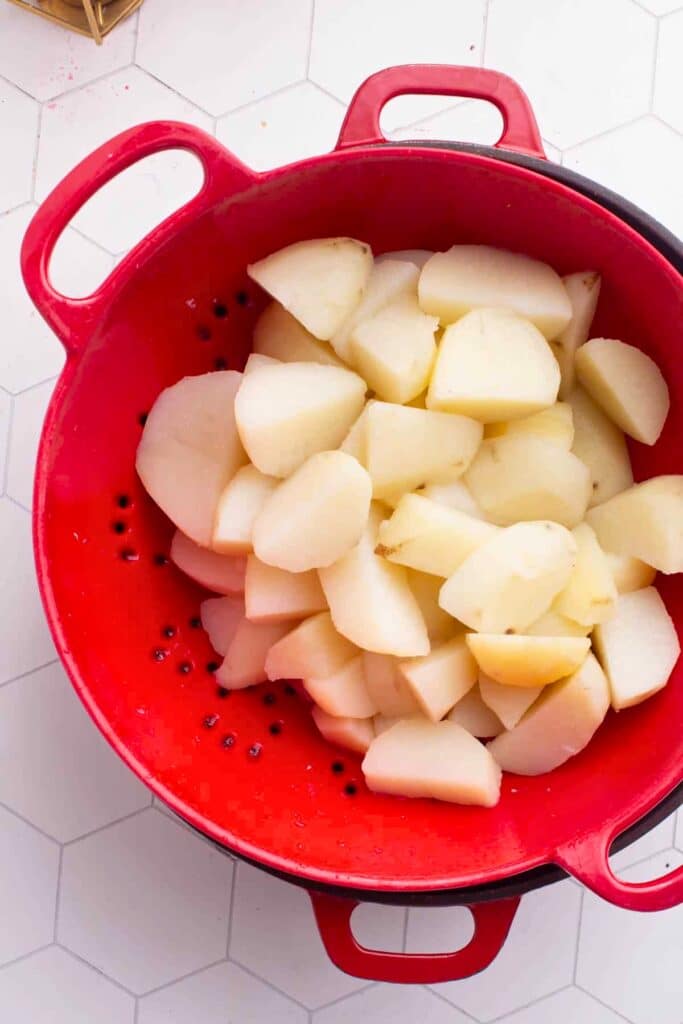
How to Make The Best Mashed Potatoes: Easy Step-by-Step Directions
Without further banter, just follow these steps to achieve creamy, flavorful mashed potatoes that will impress any dinner guest.
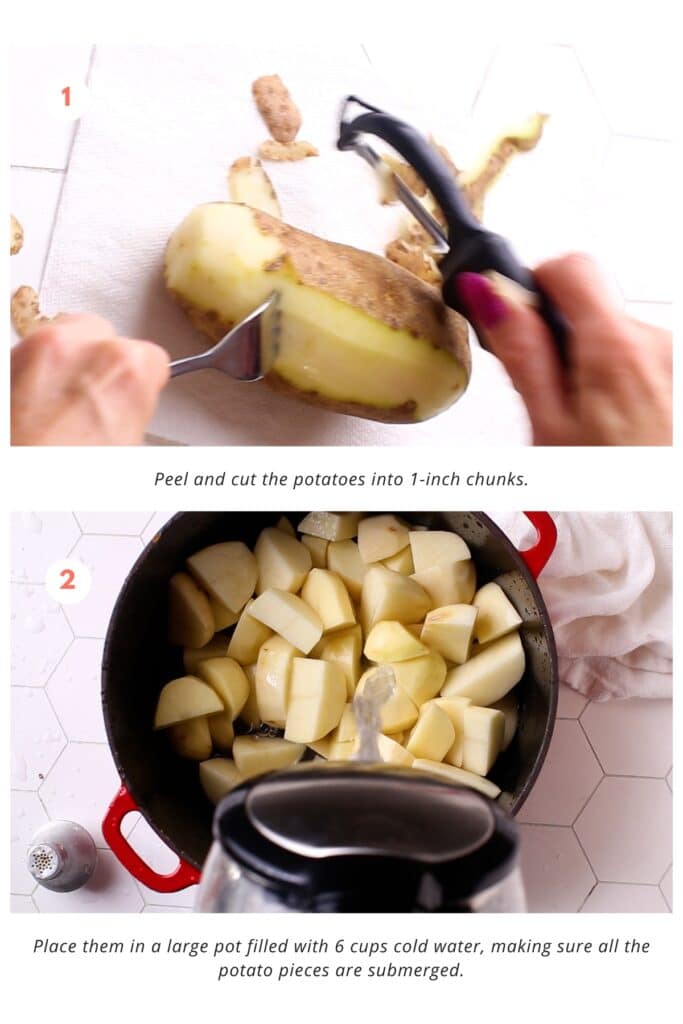
- Prep the Potatoes: Start by peeling and cutting the potatoes. Placing them in cold water ensures that they cook evenly.
- Boil the Potatoes: This step is crucial for softening the potatoes. Adding salt to the boiling water seasons the potatoes from the inside out. Monitor the tenderness by poking them with a fork.

- Heat the Dairy: While the potatoes are boiling, prepare your cream and butter mixture. Warming the dairy elements beforehand helps in easier incorporation into the mashed potatoes.
- Drain and Mash: After draining the boiled potatoes, it’s time to mash. Choose your mashing tool based on your texture preference— a potato masher for rustic and a ricer for smoother potatoes.
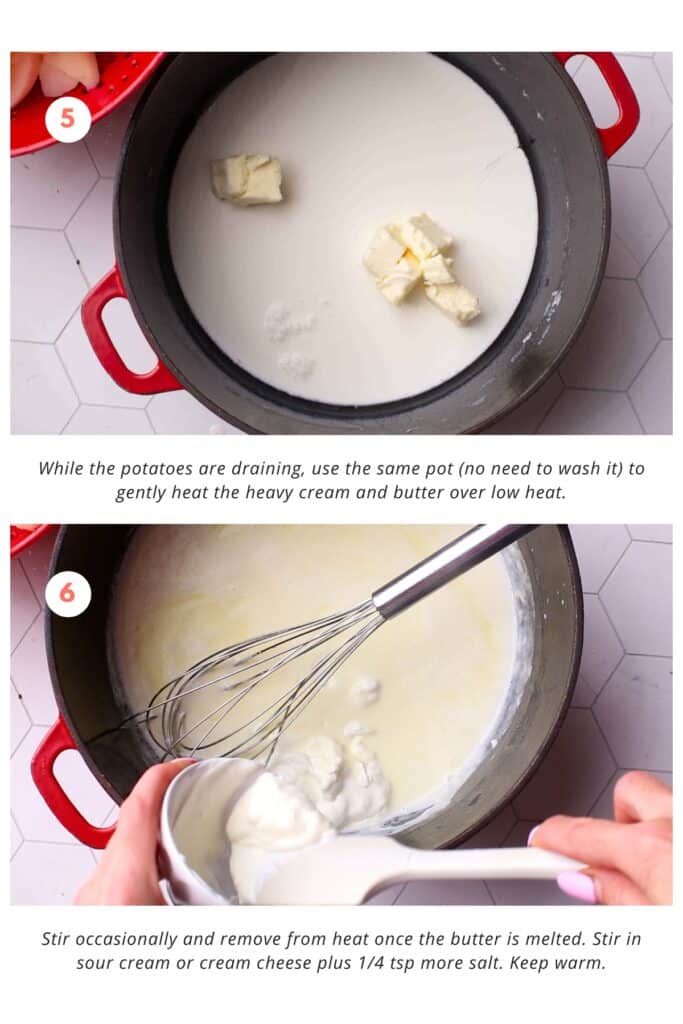
- Combine the Ingredients: This is where the magic happens. Pour your warm dairy mixture into the mashed potatoes and mix well. This gives the potatoes their creamy consistency.
- Seasoning: This step allows you to adjust the taste to your preference. Adding salt, pepper, and optional nutmeg elevates the flavors.
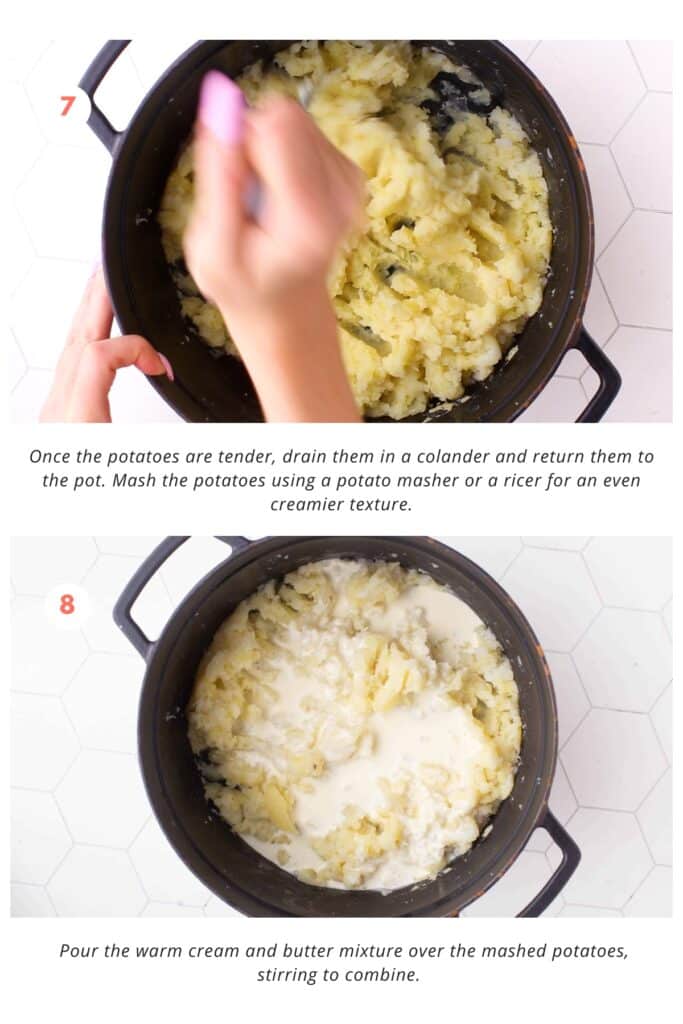
- Taste and Adjust: Always taste your mashed potatoes to adjust the seasoning. If they’re too thick, you can add more warm cream to get your preferred consistency.
- Garnish and Serve: The final step before the big reveal. Transfer your perfect mashed potatoes to a serving bowl and garnish as desired for that extra touch of elegance.
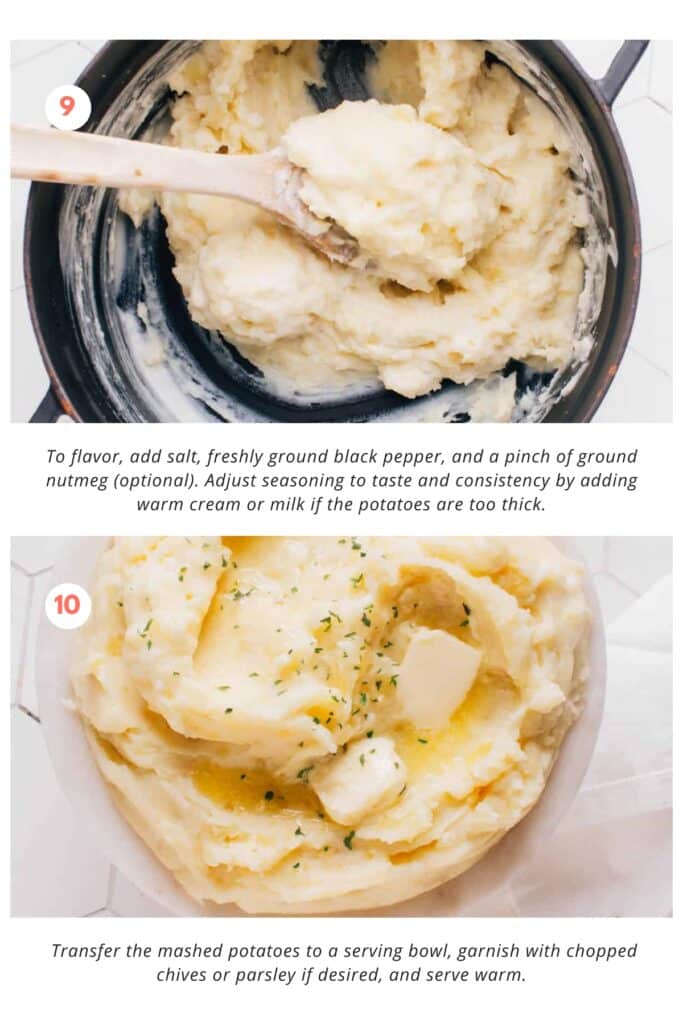
What Are the Best Potatoes for Mashed Potatoes?
Russet potatoes are often considered the best choice for mashed potatoes and other recipes for several reasons:
- High Starch Content: Russets have a high starch-to-water ratio, which makes for fluffier, smoother, and more flavorful mashed potatoes. The high starch content allows them to absorb butter and cream more easily, creating a rich and delicious dish.
- Texture: Their texture is ideal for mashing, providing a light, fluffy result rather than a gooey or pasty consistency.
- Flavor: Russet potatoes have a slightly nutty and earthy flavor that complements a wide variety of dishes. When mashed, they don’t compete with other flavors but instead create a harmonious balance.
- Uniform Shape: The relatively uniform, elongated shape of russet potatoes makes them easy to peel and cut into even-sized pieces, which is essential for cooking evenly.
- Versatility: Russet potatoes are not only excellent for mashing, but they’re also great for baking, frying, and roasting. This makes them a versatile choice in the kitchen.
- Economical: They’re usually more economical than other types of potatoes, especially when purchased in bulk.
- Availability: Russet potatoes are widely available year-round in most grocery stores, making them an accessible option.
- Absorption: The high starch content allows for better absorption of seasonings, fats, and dairy, making for a better-tasting final dish.
- Firmness: Russets maintain their structure relatively well during the boiling process, as long as they’re not overcooked. This makes it easier to achieve your desired consistency when mashing.
- Nutrient-Rich: While potatoes sometimes get a bad rap for being “empty carbs,” russet potatoes are actually a good source of nutrients like vitamin C, potassium, and dietary fiber when eaten with the skin on.
While other varieties like Yukon Gold can also make delicious mashed potatoes and may be preferred for certain recipes, russet potatoes often come out on top for their fluffy texture and ability to absorb flavors.

Why Bother Measuring the Water and Salt?
In this recipe, the salt in the cooking water is both an actual ingredient as well as part of the chemistry of great mashed potatoes.
Salting the water properly seasons the potato all the way through in the first step, so you don’t have to aggressively stir in salt later.
But it’s also about the science of osmosis that controls how water moves.
Having a higher concentration of dissolved salt in the cooking water prevents soggy potatoes. That’s because water likes to move to where there’s more “stuff” dissolved to even things out.
Properly salty cooking water means water doesn’t rush into the potato, which would make it waterlogged.
Watery, bland potatoes? No thanks.
Why Bother Heating the Cream and Butter Separately?
Heating the cream and butter before incorporating them into mashed potatoes offers several benefits that can elevate the dish:
- Even Incorporation: Warm cream and butter blend more easily with the hot, cooked potatoes. This even incorporation results in a smoother, creamier texture.
- Temperature Consistency: Adding cold cream and butter to hot potatoes can bring down the overall temperature of the dish. Pre-warming these ingredients helps keep the mashed potatoes hot and ready to serve.
- Flavor Integration: Warm fats like butter can more effectively carry flavors. If you’re infusing your cream or butter with additional flavors like garlic, herbs, or spices, warming helps to meld these flavors together better.
- Texture: Cold or room-temperature fats can sometimes re-solidify upon contact with hot potatoes, causing a less consistent texture. Warmed cream and butter ensure a velvety finish.
- Efficiency: It’s quicker to blend warm cream and butter into the potatoes. This can be a time-saver, especially if you’re cooking a big meal with multiple dishes.
- Less Work: The potatoes won’t have to work as hard to absorb the butter and cream, which means less mashing and stirring. This can help avoid the risk of over-mashing, which can make the potatoes gluey.
- Quality Control: You can more easily adjust the consistency of your mashed potatoes. If the cream and butter are warm, you can add a little at a time until you achieve your desired consistency, knowing that what you see is close to the final texture.
Overall, taking the extra step to warm the cream and butter can contribute to superior mashed potatoes that are creamy, flavorful, and perfectly textured.
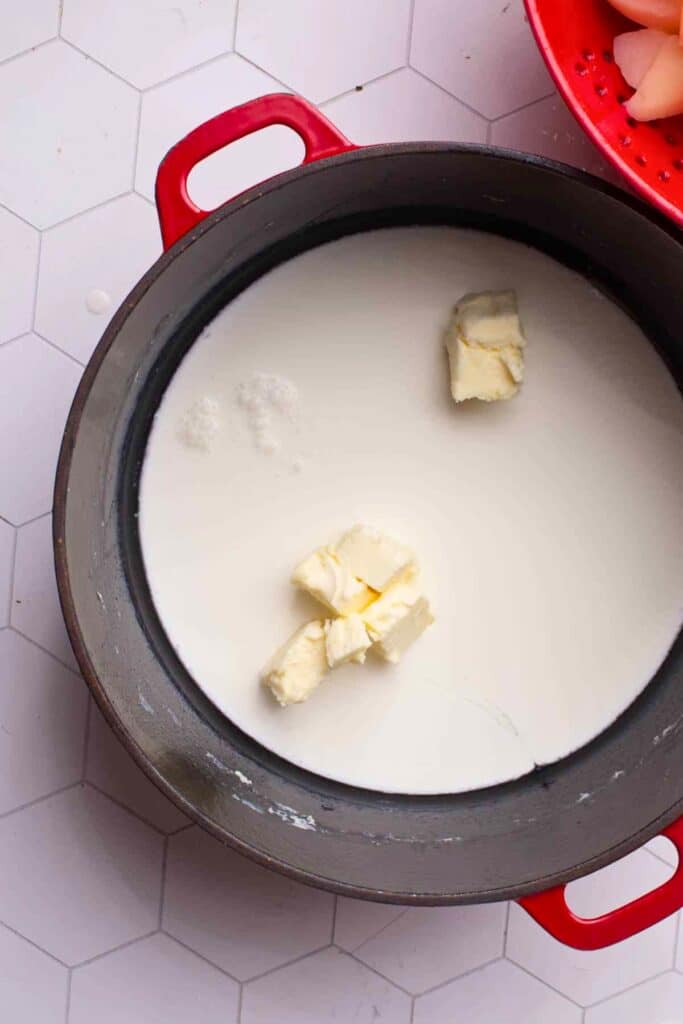
5 Common Mistakes People Make with Mashed Potatoes
Making mashed potatoes may seem simple, but there are several pitfalls that people often encounter. Here are five common mistakes to watch out for:
- Using the Wrong Potato Variety: Not all potatoes are created equal when it comes to mashing. Waxy potatoes like red or fingerling varieties can result in a gummy, sticky texture. For creamy, fluffy mashed potatoes, starchy varietites like Russet or Yukon Gold potatoes are usually the best choices.
- Adding Liquid Before Mashing: Adding milk or cream before you start mashing causes the starch to be released in a liquidy environment, where it can form a gel. This makes gluey potatoes.
- Insufficient Salt: Potatoes need a good amount of seasoning to bring out their best flavors. Many people make the mistake of not seasoning the cooking water or skimping on the salt afterwards. A well-seasoned pot of water (it should taste like the sea) can make a significant difference in the end result. It also prevents watery potatoes (see section on salt above).
- Adding Cold Butter and Cream: As discussed previously, adding cold dairy can affect both the temperature and texture of the mashed potatoes. For best results, warm your butter and cream (or milk) before adding them to the hot potatoes. This makes for smoother, creamier, and warmer mashed potatoes.
- Using an Electric Mixer or Over-Mashing: The texture of mashed potatoes can go from creamy to gluey very quickly if you overmix them. Whether you’re using a hand masher or ricer, it’s important to stop mixing as soon as the potatoes reach your desired consistency. Overmixing can cause the potato cells to break down and release too much starch, resulting in a pasty texture. Never, ever use a stand mixer, hand mixer or blender. You think you’d end up with fluffier potatoes, but you really end up with glue.
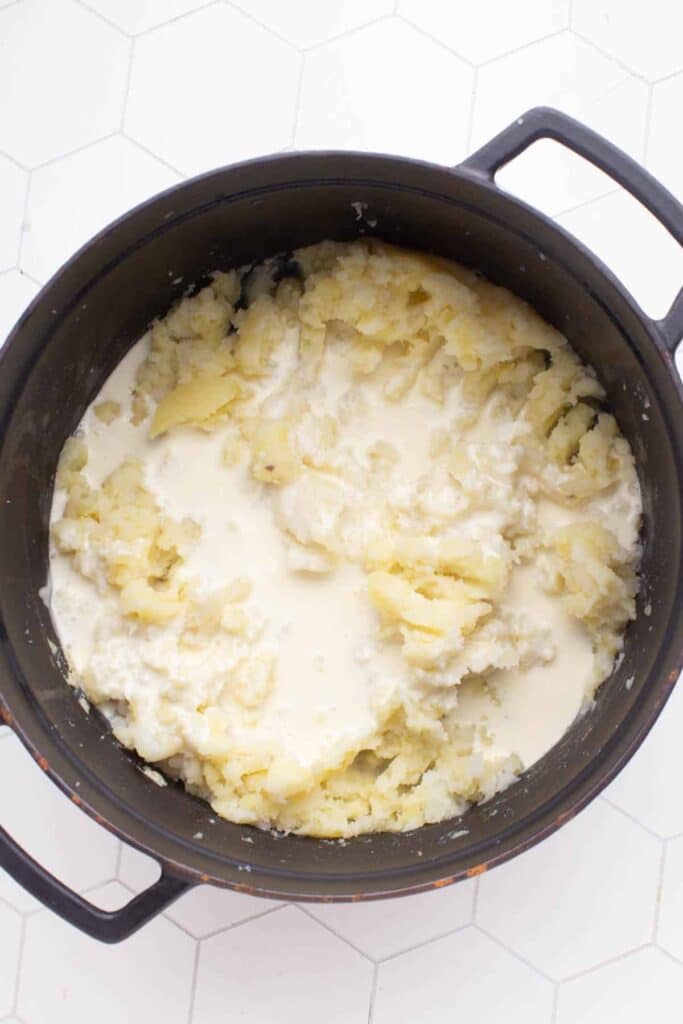
The Difference Between Amazing Mashed Potatoes Vs. Bad, Gluey Ones
Let’s break down the science behind what happens to potatoes when they’re cooked and mashed.
Starch Granules in Potatoes: Potatoes are rich in starch, which exists in the form of tiny granules embedded within the potato cells. These granules are essentially the potato’s energy storage units.
Cooking and Swelling: When you cook potatoes, these starch granules absorb water and start to swell. Imagine them as little balloons filling up with water. As they swell, they become softer, which is part of what makes cooked potatoes easy to mash.
Mechanical Action and Starch Granule Breakage: Once these starch granules are swollen, they become somewhat fragile. If you mash the potatoes too aggressively or for too long—this is what’s referred to as “mechanical action”—you can actually rupture these swollen granules.
Releasing Amylose: When a starch granule breaks open, it releases a starchy molecule called amylose into the surrounding mixture. Amylose has a tendency to form a gel-like consistency when it interacts with water or any liquid.
The Result: Gluey Texture: The released amylose can interact with the liquid, turning the mixture into a sticky, gluey, or gummy mass instead of the creamy, fluffy texture you’re aiming for in mashed potatoes.
The Solutions:
The trick to creamy, dreamy mashed potatoes is to mash them first WITHOUT any liquid, so that you’re only rupturing the starch granules without the added liquid present to make a gel.
After you’ve got the potatoes mashed up, then you can gently fold in in your warm milk or cream.
Perfect, creamy texture without gumminess.
Use a Hand Masher: Another pro tip for avoiding gluey mashed potatoes is to skip the electric mixer, blender, food processor, or other motorized technique and use a hand masher or ricer instead.
Electric appliances are way more likely to break those delicate starch parts we talked about, making your mashed potatoes gummy. So, take it back to basics and use some good old-fashioned elbow grease for the best results.

4 Pro Tips for the Best Mashed Potatoes
- Pre-Cut for Uniform Cooking: Cutting your potatoes into even-sized pieces ensures they cook uniformly. This will help you avoid a mixture of mushy and undercooked pieces.
- Rinse or Soak the Potatoes: Rinsing or soaking the cut potatoes in cold water for a few minutes can remove some surface starch, which helps in achieving a fluffier texture.
- Double Strain: After boiling, consider straining the potatoes and then putting them back into the empty, hot pot for a few minutes. This allows the residual steam to evaporate any remaining water, making your mash less soggy.
- Use a Potato Ricer: For an even fluffier texture, pass the cooked potatoes through a potato ricer rather than mashing them. This helps to create tiny, uniform pieces that absorb the butter and cream much more evenly.
4 Science-Based Secrets
- Why Russet Potatoes?: Starchy potatoes like Russets have cells that swell and separate easily when cooked, giving you that desirable fluffy texture. Waxy potatoes, on the other hand, have a more cohesive cellular structure, which can lead to gumminess.
- Salt Science: Salting the water in which you boil your potatoes does more than just season them. The salt actually changes the cooking chemistry to ensure you don’t get soggy potatoes. Read more on this above.
- Low and Slow: Cooking your potatoes at a gentle simmer rather than a rolling boil helps to cook them more uniformly and prevents them from becoming waterlogged, which can make your mashed potatoes runny.
- The Maillard Reaction for Flavor: If you really want to enhance the flavor of your mash, you can slightly brown the butter before adding it. This is due to the Maillard reaction, a chemical process that occurs when proteins and sugars in the butter react under heat, creating new flavor compounds.
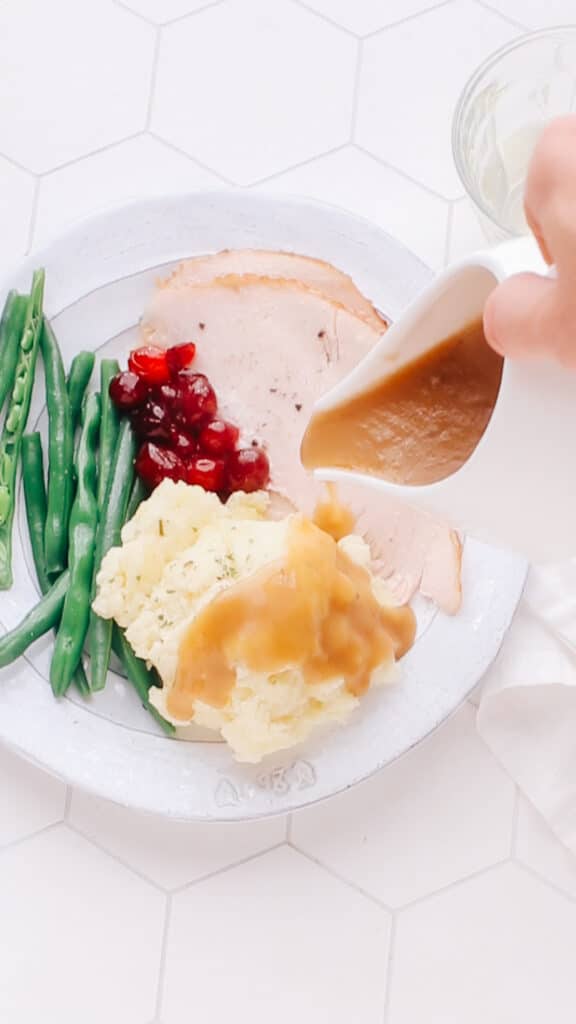
Make Ahead and Storage Tips for This Mashed Potatoes Recipe
These make-ahead and storage tips ensure you’re never more than a few minutes away from the creamy, fluffy goodness of these unparalleled mashed potatoes.
How to Freeze and Reheat Mashed Potatoes
Freezing mashed potatoes extends their shelf life up to a year and offers a quick, tasty side dish on busy days. The only caveat is that the texture may become grainier once you thaw them, but nothing a little extra butter can’t fix.
Freezing a Big Batch:
- Cool Completely: First, let your mashed potatoes cool to room temperature. This will prevent condensation from forming inside the storage container, which could lead to freezer burn.
- Choose Your Container: Use a large, airtight, freezer-safe container to store the mashed potatoes. Make sure to leave about an inch of space at the top to allow for expansion as the potatoes freeze.
- Seal Well: Press a layer of plastic wrap directly onto the surface of the mashed potatoes before sealing the lid. This extra barrier helps to reduce the risk of freezer burn.
- Label and Freeze: Clearly label the container with the date, so you know when you froze it. Properly stored, a big batch should maintain optimal quality for up to 10-12 months in the freezer.
Reheating a Big Batch:
- Stovetop Method: Empty the thawed mashed potatoes into a large pot and reheat on the stove over low heat. Stir frequently to prevent sticking.
- Add Moisture: The freezing process may affect the texture, so add a little additional cream, butter, or even a bit of chicken or vegetable broth while reheating. Start with a small amount and add more as needed.
- Taste and Adjust: Re-taste the mashed potatoes after they are heated through. You might wish to adjust the seasoning with additional salt or a thicker dairy (like sour cream or cream cheese) if they’ve gone a bit watery.
- Microwave Option: If you’re in a hurry, you can also reheat the mashed potatoes in the microwave. Use a microwave-safe dish, and heat at 50% power in 5-minute intervals, stirring between each interval, until warmed through.
Freezing Individual Portions:
- Scoop by 1/2 cup portions onto a parchment-lined baking sheet.
- Once frozen, transfer portions into airtight, freezer-safe containers or heavy-duty freezer bags.
- Reheat a scoop or two as desired, using the same method as for a big batch.

How to Serve This Mashed Potatoes Recipe
Not just for Thanksgiving dinner, this cozy side dish has a place on my table any day of the year. However, if you are making a holiday turkey, don’t miss my Guide to Turkey Dinner: A No-Stress Schedule from Shopping to Make-Ahead Cooking. Now, here’s how I like to gobble up these mashed taters.
Classic Pairing: Serve alongside roast turkey (see my super-easy roast turkey recipe) or succulent roast beef with breadcrumb crust with make-ahead herbed peppercorn gravy.
Comfort Food Combo: A perfect side for the best-ever meatloaf or my really crispy fried chicken.
Cozy Oven Dinners: Serve as a yummy side dish to oven-baked mushroom-smothered pork chops or baked salmon with mayonnaise.
I love mashed potatoes so much that I devoted an entire article to What to Eat With Mashed Potatoes (with 35+ cozy recipe ideas).
How to Use Up Leftover Mashed Potatoes
Don’t let those extra mashed potatoes go to waste! There are plenty of creative and delicious ways to give them a second life:
- Fish and Potato Cakes: Combine your mashed potatoes with flaked cooked fish (like cod, salmon or tuna), some herbs, and an egg to bind it all together. Form into cakes and pan-fry until crispy on the outside and warm on the inside.
- Turkey Stew with Mashed Potato Dumplings: Use your leftover turkey and mashed potatoes to make a comforting stew. Add small dollops of mashed potatoes directly into the simmering stew—they’ll act as delightful, pillowy dumplings.
- Malai Kofta: A luxurious Indian dish that typically uses paneer, you can substitute with mashed potatoes to make the “meatballs” in the creamy tomato-based sauce. It’s a vegetarian dream come true.
- Leftover Turkey Casserole with Stuffing Crust
- Vegetarian Shepherd’s Pie: Replace the traditional meat layer in shepherd’s pie with a hearty mix of lentils and vegetables. Top it off with a layer of your leftover mashed potatoes before baking until golden.
- Potato Samosas, Aloo Naan or Samosa Pie: Make one of these super-tasty Indian recipes. You can skip boiling the potatoes from scratch and add your sauteed Aloo Masala seasonings and spices directly to pre-cooked mashed potatoes.
Give these ideas a try and turn your leftovers into new, exciting dishes!
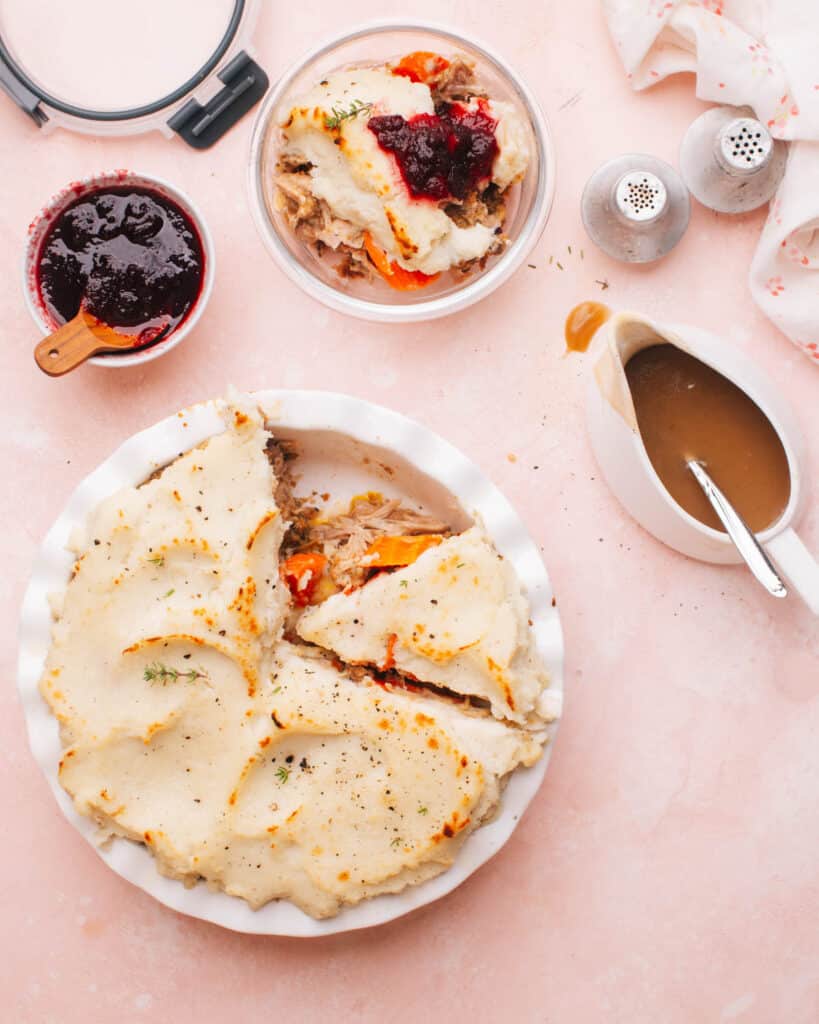
FAQs
Consider this the “too-long-didn’t-read” section in case you just skimmed the article.
The key to good mashed potatoes lies in the quality of the potatoes, proper seasoning, and the right balance of butter and cream. Starting with cold water for even cooking and using a potato ricer can also make a world of difference.
Russet potatoes are generally considered the best for mashing due to their high starch content.
While russet potatoes are recommended for their fluffy texture, you can also use Yukon Gold potatoes for a creamier, buttery texture.
Peeling is optional and depends on your preference for texture. Some people like the rustic feel of skin-on mashed potatoes.
Starting with cold water ensures even cooking. Hot water can cook the outer layers of the potato too quickly.
Yes, you can use milk, but the mashed potatoes will be less rich. For a lighter version, you can even use chicken or vegetable broth.
While sour cream and cream cheese add richness and tang, you can omit them or substitute with Greek yogurt.
The easiest way to mash potatoes is by using a potato masher or a fork. Simply press down and crush the boiled potatoes until you reach your desired consistency.
Professional chefs often use a potato ricer for the smoothest, lump-free mashed potatoes.
Overmixing or using an electric mixer or food processor can break down the starches too much, leading to a gluey texture. Stick to a hand masher or ricer.
Apart from the basics like butter, cream, and salt, you can add sour cream, cream cheese, a couple of cloves garlic, a tablespoon or two of minced chives, or even a pinch of nutmeg for extra flavor.
Yes, you can make them a day in advance. Reheat them gently on the stovetop or in the microwave, adding a bit more cream or milk to restore the creamy texture.
Leftovers can be stored in an airtight container in the fridge for up to 3 days. You can also freeze them for up to 2 months.
Yes, but the texture may change slightly when thawed. It’s best to reheat them with a bit of extra cream or butter to revive the texture. Full details and instructions are outlined in the article above.
Restaurant mashed potatoes often taste better due to high-fat content, like butter and heavy cream. Chefs also season them well, with lots of salt.
Gordon Ramsay’s mashed potatoes are known for their richness and flavor. He typically adds butter, heavy cream, and sometimes crème fraîche to his mashed potatoes for a creamy and indulgent texture. Additionally, he often incorporates roasted garlic or chives for extra flavor.

The Best Mashed Potatoes Recipe You’ll Ever Try
Ingredients
- 4 lbs russet potatoes peeled and cut into 1-inch chunks
- 6 cups cold water
- 1 tbsp kosher salt plus more to taste
- ½ cup unsalted butter 1 stick
- 1 cup heavy cream
- ¼ cup sour cream or cream cheese
- Freshly ground black pepper to taste
- Chopped fresh chives or parsley for garnish optional
Instructions
- Prep the Potatoes: Peel and cut the potatoes into 1-inch chunks. Place them in a large pot filled with 6 cups cold water, making sure all the potato pieces are submerged.
- Boil the Potatoes: Add 1 tbsp salt to the water. Bring the pot to a boil over high heat, then reduce the heat to medium and simmer for about 15-20 minutes, or until the potatoes are tender when pierced with a fork. Pour into a colander to drain.
- Heat the Dairy: While the potatoes are draining, use the same pot (no need to wash it) to gently heat the heavy cream and butter over low heat. Stir occasionally and remove from heat once the butter is melted. Stir in sour cream or cream cheese plus 1/4 tsp more salt. Keep warm.
- Drain and Mash: Once the potatoes are tender, drain them in a colander and return them to the pot. Mash the potatoes using a potato masher or a ricer for an even creamier texture.
- Combine: Pour the warm cream and butter mixture over the mashed potatoes, stirring to combine. Season with salt, freshly ground black pepper, and a pinch of ground nutmeg if using.
- Taste and Adjust: Taste the mashed potatoes and adjust the seasoning as needed. If the potatoes are too thick, you can add a little more warm cream or milk to reach your desired consistency.
- Garnish and Serve: Transfer the mashed potatoes to a serving bowl, garnish with chopped chives or parsley if desired, and serve warm.
Video
Nutrition
Nutrition information is automatically calculated, so should only be used as an approximation.
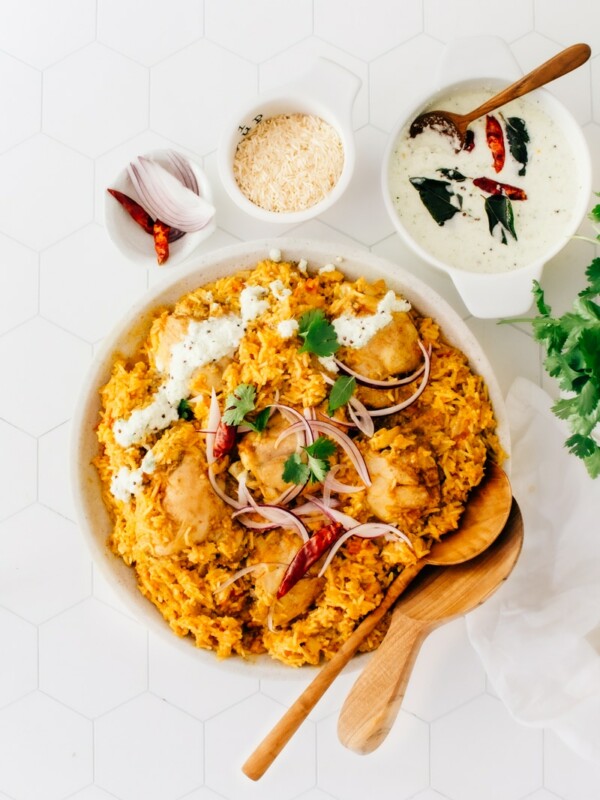
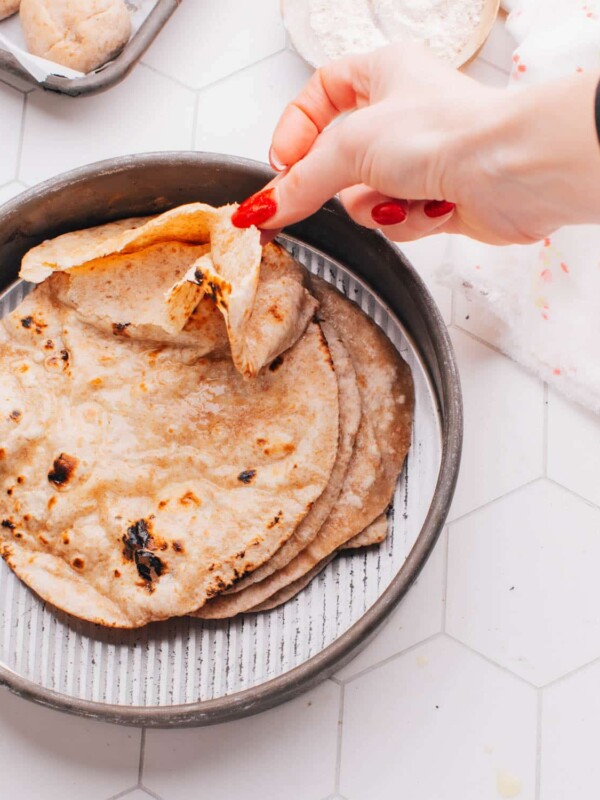
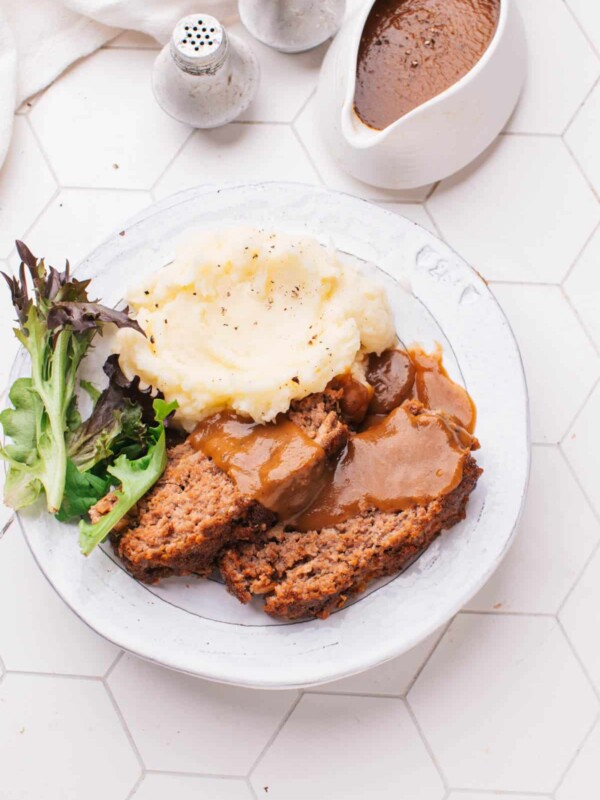
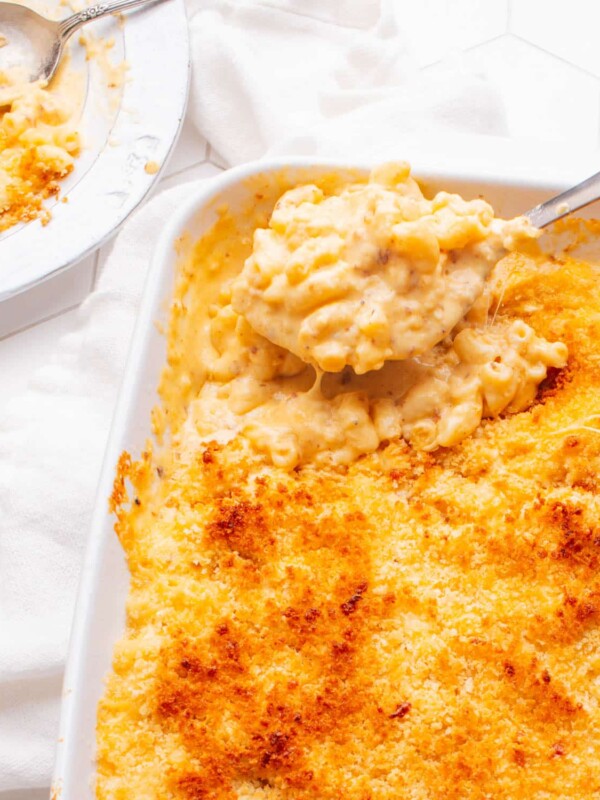











My sister made these for our family for Thanksgiving this weekend and they were absolute heaven. She didn’t change a thing and they were the most perfect mashed potatoes. THANK YOU!